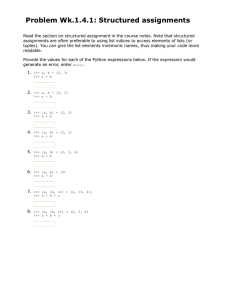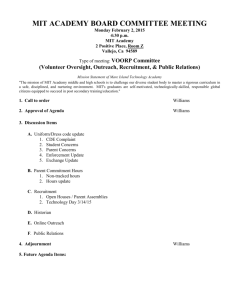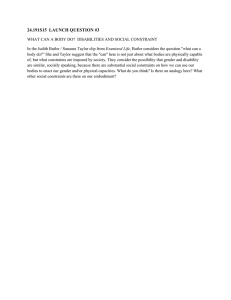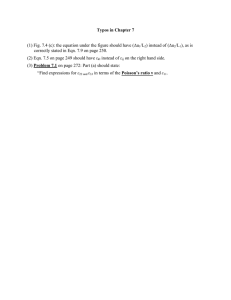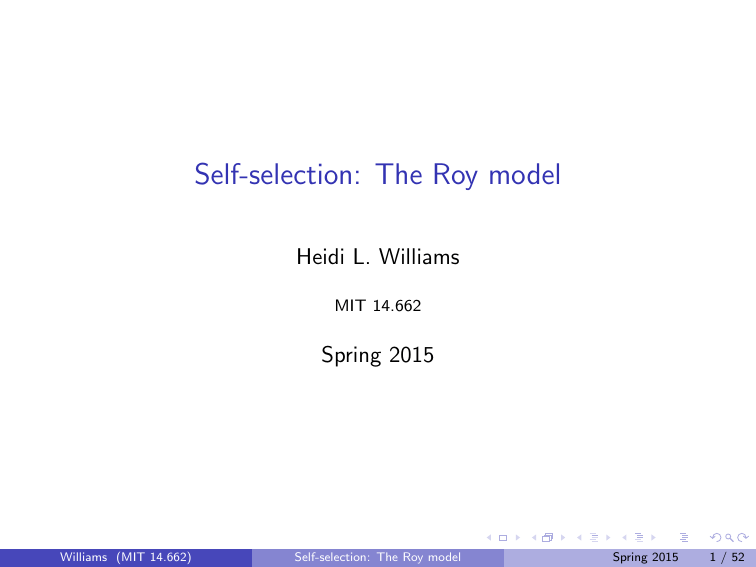
Self-selection: The Roy model
Heidi L. Williams
MIT 14.662
Spring 2015
Williams (MIT 14.662)
Self-selection: The Roy model
Spring 2015
1 / 52
1
Roy model application #1: Health care
2
Roy model application #2: Redistribution
3
Looking ahead
Williams (MIT 14.662)
Self-selection: The Roy model
Spring 2015
2 / 52
1
Roy model application #1: Health care
2
Roy model application #2: Redistribution
3
Looking ahead
Williams (MIT 14.662)
Self-selection: The Roy model
Spring 2015
3 / 52
Roy model: Physician practice patterns
Despite its origin in labor economics, the Roy model has been applied
across a wide range of fields in economics
Chandra and Staiger (2007): one of the most important papers in health
economics in recent years, and one that has really changed how people
think about a variety of issues
Williams (MIT 14.662)
Self-selection: The Roy model
Spring 2015
4 / 52
Geographic variation in medical expenditures
Earliest work I’m aware of: Glover (1938)
�
�
�
England and Wales: variation in small-area tonsillectomy rates
Looked for correlations with “any factor which might have some
ætiological bearing on chronic tonsillitis and adenoidal growths - such
factors for example as overcrowding...not the slightest suggestion of
correlation has been obtained.”
Maybe not the regressions we would estimate, but the start of a puzzle!
Skinner (2012) Handbook chapter provides overview of this literature
�
�
Adjusting for prices doesn’t really matter (Gottlieb et al. 2010)
Debate over relative importance of supply vs. demand
Williams (MIT 14.662)
Self-selection: The Roy model
Spring 2015
5 / 52
Geographic variation in medical expenditures (continued)
“Fact” #1: geographic variation in health spending is not associated
with improved satisfaction, outcomes, or survival
�
I
I
�
Consensus view from Dartmouth Atlas
Caveats: Cutler (2005), Joe Doyle’s line of research
Surprising in light of Fact #2: many technologies shown to be
associated with improved survival in randomized clinical trials
Facts #1, 2 often reconciled by “flat of the curve” argument
I
�
I
�
RCTs run on patients most likely to benefit
Physicians may treat until marginal return is zero
Williams (MIT 14.662)
Self-selection: The Roy model
Spring 2015
6 / 52
Three problems with “flat of the curve” argument
1
2
No explanation of why we observe geographic variation
Still predicts positive relationship between spending, outcomes unless
all areas in range of zero or negative marginal benefits
�
I
3
Has never been documented in the literature
Predicts marginal benefit from more intensive treatment should be
lower in areas that treat more aggressively
�
I
Available US-Canada comparisons suggest the opposite: US treats
heart attacks more intensively, yet marginal benefit from intensive heart
attack treatments appears to be larger in US
Williams (MIT 14.662)
Self-selection: The Roy model
Spring 2015
7 / 52
Chandra and Staiger (2007)
Chandra and Staiger present a Roy model with productivity spillovers that
can reconcile these facts.
Their paper is an excellent illustration of how a set of facts can motivate a
(relatively simple) theoretical framework producing testable implications
that can then be taken back to the data.
Williams (MIT 14.662)
Self-selection: The Roy model
Spring 2015
8 / 52
What motivates a model with productivity spillovers?
Patients receive either of two treatments:
1
2
Nonintensive management (medical management; subscript 1)
Intensive intervention (surgery; subscript 2)
Physicians choose treatment to maximize utility over expected
survival (Survival1 , Survival2 ) and cost (Cost1 , Cost2 )
Productivity spillovers: survival, cost positively related to share of
patients receiving same treatment (P1 , P2 = 1 − P1 )
�
I
As in Katz and Shapiro’s (1985) model of network externalities
(telephones, hardware-software, foreign auto firms)
Williams (MIT 14.662)
Self-selection: The Roy model
Spring 2015
9 / 52
What motivates a model with productivity spillovers?
Why would this productivity spillovers assumption be plausible? Chandra
and Staiger focus on three possible explanations:
1
Knowledge spillovers. Physicians may learn about new surgical
techniques and procedures from direct contact with other physicians
(“see one, do one, teach one”)
2
Availability of support services. Some places have cardiac
catheterization labs whereas other don’t (choice variable)
3
Selective migration. Physicians more skilled at the intensive
treatment may self-select into areas that treat more intensively
Williams (MIT 14.662)
Self-selection: The Roy model
Spring 2015
10 / 52
Model
To the basic framework outlined above, add heterogeneity across patients
that affects expected survival and cost
Some heterogeneity captured by observable characteristics (Z )
Other factors (E) known to patient and physician at the time of
choosing treatment, but not observed by econometrician
This is the Roy model component of the model: patients are sorted into
the two treatments based on expected returns
Williams (MIT 14.662)
Self-selection: The Roy model
Spring 2015
11 / 52
Model (continued)
For treatments i ∈ {nonintensive, intensive}, denote the survival rate and
cost for each treatment as:
Survivali = βis Z + αis Pi + Esi for i = 1, 2
Costi = βic Z + αic Pi + Eci for i = 1, 2
Denoting value of life ( survival
) by λ, patient’s indirect utility U is:
$
Ui = Survivali − λCosti = βi Z + αi Pi + Ei for i = 1, 2
where βi = βis − λβic , αi = αis − λαic , and Ei = Eis − λEic
βi Z : index of patient appropriateness for each treatment (e.g. age)
αi Pi : productivity spillover (α could be zero)
Ei : unobservables that influence survival and cost
Note λ could be 0 due to insurance
Williams (MIT 14.662)
Self-selection: The Roy model
Spring 2015
12 / 52
Model (continued)
An individual is treated intensively (i = 2) if U2 > U1 (treatment
maximizes patient U, not accounting for externalities). Recall P1 = 1 − P2 :
Pr{intensive} = Pr{i = 2}
= Pr{U2 − U1 > 0}
= Pr{β2 Z + α2 P2 + E2 − β1 Z − α1 (1 − P2 ) − E1 > 0}
= Pr{P2 (α1 + α2 ) − α1 + (β2 − β1 )Z > E1 − E2 }
= Pr{αP2 − α1 + βZ > E}
where α = α1 + α2 , β = β2 − β1 , and E = E1 − E2
Williams (MIT 14.662)
Self-selection: The Roy model
Spring 2015
13 / 52
Model (continued)
Among the patients who choose the intensive treatment, the expected
utility gain is:
E [U2 − U1 |U2 − U1 > 0] = βZ + αP2 − α1 + E [E|U2 − U1 > 0]
⇒ patients receiving treat2 have higher expected utility gain if:
1
More appropriate (higher βZ )
2
Live in a more intensive region (higher αP2 )
Intuition: patients are given the best care conditional on where they live,
but marginal patients would be better off in area with other specialization.
Williams (MIT 14.662)
Self-selection: The Roy model
Spring 2015
14 / 52
Equilibrium (fixed point) condition
Let f (Z ) denote distribution of Z . In equilibrium, fraction of patients
choosing intensive treatment (P2 ) must match demand equation for
Pr{intensive treatment}.
That is, proportion of patients choosing intensive treatments must
generate benefits (with productivity spillovers) consistent with proportion.
�
Pr{αP2 − α1 + βZ > E}f (Z )dZ
P2 =
Z
= G (P2 )
Variation across areas in use of intensive treatment can arise for two
reasons: multiple equilibria, or single equilibrium determined by small
differences in patient characteristics
Williams (MIT 14.662)
Self-selection: The Roy model
Spring 2015
15 / 52
Equilibrium
Variation across areas in treat2 can
arise for two reasons:
1(A): Multiple (here: two) stable
equilibria: intensive (high returns to
treat2 ) and non-intensive (low
returns to treat2 ); no prediction on
choice
1(B): Single equilibrium determined
by small differences in patient
characteristics: productivity spillovers
can magnify small differences
© The University of Chicago Press. All rights reserved. This content is
excluded from our Creative Commons license. For more information,
see http://ocw.mit.edu/help/faq-fair-use/.
Williams (MIT 14.662)
Self-selection: The Roy model
Spring 2015
16 / 52
Equilibrium: Key figure
Ignore E, plot U against Z
Think of Z as propensity score of
appropriateness for treat2
(age, comorbidities)
© The University of Chicago Press. All rights reserved. This content is
excluded from our Creative Commons license. For more information,
see http://ocw.mit.edu/help/faq-fair-use/.
Williams (MIT 14.662)
Self-selection: The Roy model
Spring 2015
17 / 52
Equilibrium: Key figure
Figure 2(a): within-area, gap between
treat1 and treat2 larger for more
appropriate patients (⇒ returns are
higher for these patients)
© The University of Chicago Press. All rights reserved. This content is
excluded from our Creative Commons license. For more information,
see http://ocw.mit.edu/help/faq-fair-use/.
Williams (MIT 14.662)
Self-selection: The Roy model
Spring 2015
18 / 52
Equilibrium: Key figure
Figure 2(b):
1
Less appropriate patients worse
off in intensive areas
2
Marginal patient less appropriate
in intensive areas
3
More appropriate patients better
off in intensive areas
© The University of Chicago Press. All rights reserved. This content is
excluded from our Creative Commons license. For more information,
see http://ocw.mit.edu/help/faq-fair-use/.
Williams (MIT 14.662)
Self-selection: The Roy model
Spring 2015
19 / 52
Welfare
Spillovers ⇒ increase in P2 has positive externality on some patients,
negative externality on others
Unsurprisingly, externalities ⇒ equilibrium may not be optimal
Single vs. multiple equilibrium cases matter for welfare
�
I
�
I
Multiple: “area approach” can determine optimal P2
Single: too little area variation in treatment as long as marginal patient
ignores externality she imposes
Williams (MIT 14.662)
Self-selection: The Roy model
Spring 2015
20 / 52
Data
Context: heart attacks (‘acute myocardial infarctions’)
�
I
�
I
I
�
I
�
Common condition
Extensive data (Medicare claims + CCP chart data)
Relatively high mortality rate
Limited role for patients to select providers
Treatments:
I
�
I
�
Non-intensive: beta blockers (note: should be prescribed to all)
Intensive: cardiac catheterization
‘Standard’ market definitions: 306 ‘hospital referral regions’
Assign patients to HRR of residence, not treatment
Williams (MIT 14.662)
Self-selection: The Roy model
Spring 2015
21 / 52
Estimation
Partition patients into groups (k) based on appropriateness for treat2
For Outcomeijk ∈ {Survivalijk , Costijk } for patient i in HRR j and group k,
key estimating equation is:
Outcomeijk = β0k + β1k Intensive Treatmenti + Xi Πk + uijk
What is the potential problem with this OLS regression?
IV: ‘differential distance’ (McClellan et al. 1994)
�
I
Distance to nearest cath hospital minus distance to nearest noncath
hospital (negative ⇒ nearest hospital is cath hospital)
Appropriateness measure: Pr(Cardiac Cathij ) = Ĝ (θ0 + Xi Φ)
Williams (MIT 14.662)
Self-selection: The Roy model
Spring 2015
22 / 52
Results
Two sets of results:
Testing implications of the Roy model
1
2
Returns to intensive treatment increase in appropriateness
Marginal patient less appropriate in intensive areas
Testing implications of productivity spillovers
1
2
3
4
5
Quality of medical management worse in intensive areas
Characteristics of other patients influence treatment
Returns to intensive treatment higher in intensive areas
Most appropriate patients better off in intensive areas
Least appropriate patients worse off in intensive areas
Williams (MIT 14.662)
Self-selection: The Roy model
Spring 2015
23 / 52
Results: Table 1
IV: outcome = f(cath),
survival = f(spending)
More appropriate
patients benefit more
from treat2 :
0.038 vs. 0.002 in
Column 3; higher
survival, lower costs
Similar results with age
Consistent with Roy
model
© The University of Chicago Press. All rights reserved. This content is
excluded from our Creative Commons license. For more information,
see http://ocw.mit.edu/help/faq-fair-use/.
Williams (MIT 14.662)
Self-selection: The Roy model
Spring 2015
24 / 52
Results: Table 2
Split the sample by above/below median values of instrument
1
1
Predicts cath (first stage, 48.9 - 42.8 = 6.1pp)
2
2
Predicts survival (reduced form, 67.6 - 66.7 = 0.9pp)
3
3
Doesn’t predict ‘predicted survival’ (67.5 - 67.2 = 0.3pp)
4
4
Columns (7) and (8) argue marginal patients similar to average
© The University of Chicago Press. All rights reserved. This content is
excluded from our Creative Commons license. For more information,
see http://ocw.mit.edu/help/faq-fair-use/.
Williams (MIT 14.662)
Self-selection: The Roy model
Spring 2015
25 / 52
Results: Figure 3
Test in the spirit of Gruber
et al. (1999)
Sample: patients
receiving cath
Patient
appropriateness =
f(log, risk-adjusted
HRR cath rate)
Negative: average
patient
appropriateness lower
in more intensive areas
Consistent with Roy
model
Williams (MIT 14.662)
© The University of Chicago Press. All rights reserved. This content is
excluded from our Creative Commons license. For more information,
see http://ocw.mit.edu/help/faq-fair-use/.
Self-selection: The Roy model
Spring 2015
26 / 52
Results: Table 4
Quality of
non-intensive
treatment (beta
blockers) worse
in intensive areas:
-0.31
Consistent with
productivity
spillovers
© The University of Chicago Press. All rights reserved. This content is
excluded from our Creative Commons license. For more information,
see http://ocw.mit.edu/help/faq-fair-use/.
Williams (MIT 14.662)
Self-selection: The Roy model
Spring 2015
27 / 52
Results: Table 5
Cath = f(average appropriateness of patients in your HRR)
1pp increase in average propensity of patients in your HRR
⇒ 0.53pp increase in the probability you receive cath
Consistent with productivity spillovers
© The University of Chicago Press. All rights reserved. This content is
excluded from our Creative Commons license. For more information,
see http://ocw.mit.edu/help/faq-fair-use/.
Williams (MIT 14.662)
Self-selection: The Roy model
Spring 2015
28 / 52
Results: Table 6
IV: outcome = f(cath),
survival = f(spending)
(like Table 1, but area)
Returns to treat2 higher
in intensive areas (0.038
vs. 0.009); opposite
prediction from “flat of
the curve” model
Difference in IV from
survival, not costs
Consistent with
productivity spillovers
Williams (MIT 14.662)
© The University of Chicago Press. All rights reserved. This content is
excluded from our Creative Commons license. For more information,
see http://ocw.mit.edu/help/faq-fair-use/.
Self-selection: The Roy model
Spring 2015
29 / 52
Results: Table 7
OLS: outcome =
f(HRR-level cath rate)
On average, no return to
spending; hides important
heterogeneity
Intensive areas: appropriate
patients better off (0.052),
less appropriate patients
worse off (-0.075)
REALLY striking
Consistent with
productivity spillovers
© The University of Chicago Press. All rights reserved. This content is
excluded from our Creative Commons license. For more information,
see http://ocw.mit.edu/help/faq-fair-use/.
Williams (MIT 14.662)
Self-selection: The Roy model
Spring 2015
30 / 52
Take-aways
‘Facts’ of geographic variation have been around a long time
�
I
I
�
Health economists’ favorite puzzle: tremendous variation in medical
spending across observationally similar patients
Caveat: other industries...
High impact paper: simple model, careful empirics
Not your ‘standard’ IV paper
Not much on mechanisms for productivity spillovers
Very policy relevant, but pretty silent on welfare
�
I
I
�
I
�
Is high spending evidence of overuse?
Can’t infer overuse if productivity is heterogeneous
Chandra-Staiger (2011):
“Expertise, overuse, and underuse in health care”
Williams (MIT 14.662)
Self-selection: The Roy model
Spring 2015
31 / 52
Expertise, overuse, and underuse in health care
Variation in treatment intensity across hospitals due to:
1
1
2
2
3
3
Greater benefits of treatment (“expertise”)
Withholding of treatment (“underuse”)
Providing harmful treatment (“overuse”)
Model:
I
�
I
�
I
�
I
�
Expected benefit from treatment: Bih = αh + Xih β + Eih
Expertise: αh
Hospital treats if Bih exceeds hospital-specific threshold τh
E (Bih |treatih = 1) = αh + Xih β + E (Eih | − Eih < Xih β + αh − τh )
Tentative conclusion: Expertise varies widely, lots of overuse
Won’t go through empirics, just an example
Williams (MIT 14.662)
Self-selection: The Roy model
Spring 2015
32 / 52
Different model/example: Prostate cancer
Two treatment options: surgery, watchful waiting
Assume PSA score is a perfect risk adjuster
�
I
Different from Chandra-Staiger: No uncertainty
Patients as good as randomly allocated to providers
Providers use a threshold rule
Frame as a regression discontinuity (RD) framework
�
I
Goal: Clarify how parameters are identified in the data
Want to identify:
I
�
I
�
αh : Hospital “expertise”
τh : Look for evidence of overuse/underuse (τh Z 0)
Williams (MIT 14.662)
Self-selection: The Roy model
Spring 2015
33 / 52
Williams (MIT 14.662)
Self-selection: The Roy model
Spring 2015
34 / 52
Williams (MIT 14.662)
Self-selection: The Roy model
Spring 2015
35 / 52
Williams (MIT 14.662)
Self-selection: The Roy model
Spring 2015
36 / 52
Williams (MIT 14.662)
Self-selection: The Roy model
Spring 2015
37 / 52
Williams (MIT 14.662)
Self-selection: The Roy model
Spring 2015
38 / 52
Same tau, less appropriate X ’s ⇒ higher αh
Williams (MIT 14.662)
Self-selection: The Roy model
Spring 2015
39 / 52
Williams (MIT 14.662)
Self-selection: The Roy model
Spring 2015
40 / 52
Connecting this to the Chandra-Staiger model
Identification of τh is clearer than is identification of αh
In RD framework, αh is identified by comparing realized returns
across hospitals using the same threshold
How is αh identified in Chandra-Staiger?
�
I
�
I
Component of treatment returns common across patients in h
Is this how we would ideally model expertise?
*
*
�
I
What if good at treating easy but not complicated patients?
Does this complicate decomposition exercise?
Estimation of αh is very important, because αh pins down where
6 0
hospital A’s optimal threshold is if currently τA =
*
*
Key input into welfare analysis with counterfactuals
Exactly what RD can’t tell us: Almond et al. (2010) example
Williams (MIT 14.662)
Self-selection: The Roy model
Spring 2015
41 / 52
Add’l application: Welfare effects of fixed thresholds
Treatment guidelines based only on patient characteristics
�
I
I
�
I
�
Care for newborns: e.g. birthweight ≤ 1250g
Prostate cancer antigen (PSA) score: e.g. PSA = 4
Hypertension: e.g. systolic blood pressure ≥ 160mm
Implicit assumption: all variation is driven by τh , not αh
Criticisms of guidelines usually focus on patient heterogeneity
But: heterogenous productivity ⇒ different optimal thresholds
Chandra-Staiger model could be applied to estimate the welfare gains
and losses from uniform treatment guidelines
I
�
Net welfare effect ambiguous
*
*
I
�
Welfare gain from limiting overuse or avoiding underuse
Welfare loss from heterogeneous hospitals using fixed threshold
Could estimate policy counterfactuals, conduct welfare analysis
Williams (MIT 14.662)
Self-selection: The Roy model
Spring 2015
42 / 52
1
Roy model application #1: Health care
2
Roy model application #2: Redistribution
3
Looking ahead
Williams (MIT 14.662)
Self-selection: The Roy model
Spring 2015
43 / 52
Abramitsky (2009)
Series of papers - and a book (in progress) - investigating the
equality-incentives trade-off in the context of the Israeli kibbutz
Key features:
1
1
2
2
3
3
Equal sharing in the distribution of income
No private property
Non-cash economy
PF literature: expect mobility in response to redistributive policies
Roy model:
�
I
I
�
Positive self-selection of migrants expected when place of origin has
lower returns to skill (more redistribution) than destination
Negative self-selection of migrants expected when place of origin has
higher returns to skill (less redistribution) than destination
Abramitsky (2009) tests these ideas in context of Israeli kibbutzim
�
I
As in work on US immigration, takes advantage of a new longitudinal
data set of individuals linked across population censuses
Williams (MIT 14.662)
Self-selection: The Roy model
Spring 2015
44 / 52
Data
Random representative sample of individuals linked between 1983 and
1995 Israeli Censuses of Population
�
I
Censuses identify individuals who life in “a cooperative rural
settlement, in which production, marketing, and consumption are
organized in a cooperative manner” (kibbutz members)
Focuses on Jewish individuals between the ages of 21 and 54 in 1983
(ages of 33 and 66 in 1995)
Williams (MIT 14.662)
Self-selection: The Roy model
Spring 2015
45 / 52
Three subsamples
1
1983 kibbutz members and other rural residents also observed in 1995
I
�
2
City residents observed in 1995, including individuals who migrated
from the kibbutz and from other rural areas between 1983 and 1995
I
�
3
Compare kibbutz-to-city migrants both with kibbutz members who
stayed in their kibbutz and with other rural-to-city migrants
Analyze earnings of kibbutz-to-city migrants in the city labor market
compared with earnings of city natives and other rural-to-city migrants
City residents observed in 1983, including individuals who would
migrant to kibbutz or other rural localities between 1983 and 1995
I
�
Compare the pre-entry earnings of city-to-kibbutz migrants with the
earnings of city stayers and city-to-other rural migrants
Williams (MIT 14.662)
Self-selection: The Roy model
Spring 2015
46 / 52
Summary statistics on entry and exit
A total of 343 out of the 1577 individuals in the sample who lived in a
kibbutz in 1983 left the kibbutz between 1983 and 1995, over 20%
A total of 90 out of the 16,789 individuals in the sample who lived
outside of kibbutzim in 1983 (with non-missing earnings) entered a
kibbutz in this period, around 0.5%
�
I
I
�
Note: low in part because screening mitigates adverse selection
Makes it harder to document negative selection
Williams (MIT 14.662)
Self-selection: The Roy model
Spring 2015
47 / 52
Testing for positive selection in exit
More educated members and those with higher skilled occupations are
more likely to leave kibbutzim, and this skill bias in out-migration is
stronger in kibbutzim than in other rural localities. These results suggest a
positive selection away from redistribution.
Courtesy of Elsevier, Inc. http://www.sciencedirect.com. Used with permission.
Williams (MIT 14.662)
Self-selection: The Roy model
Spring 2015
48 / 52
Testing for negative selection in entry
Individuals with lower wages are more likely to enter a kibbutz.
Courtesy of Elsevier, Inc. http://www.sciencedirect.com. Used with permission.
Williams (MIT 14.662)
Self-selection: The Roy model
Spring 2015
49 / 52
Take-aways
Paper formalizes these results, but I like that the key ideas are clearly
illustrated in these two simple figures
Broader research agenda uses the kibbutz as a laboratory for
understanding how one form of intensive redistribution was able to
survive over time; many kibbutzim eventually moved away from full
equal sharing to something closer to capitalism and taxation
Williams (MIT 14.662)
Self-selection: The Roy model
Spring 2015
50 / 52
1
Roy model application #1: Health care
2
Roy model application #2: Redistribution
3
Looking ahead
Williams (MIT 14.662)
Self-selection: The Roy model
Spring 2015
51 / 52
Looking ahead
Equalizing wage differentials
For next Wednesday: Please read Goldin-Katz (forthcoming, JOLE)
Williams (MIT 14.662)
Self-selection: The Roy model
Spring 2015
52 / 52
MIT OpenCourseWare
http://ocw.mit.edu
14.662 Labor Economics II
Spring 2015
For information about citing these materials or our Terms of Use, visit: http://ocw.mit.edu/terms .

